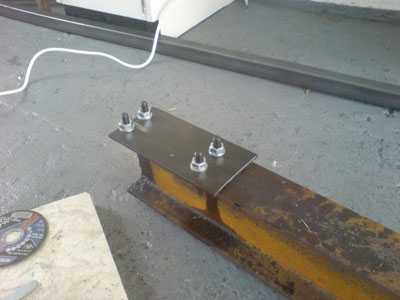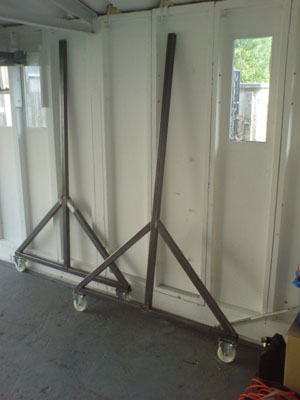Mark Thomas's Website
Current: /Other/Workshop/Gantry Crane

Menu:
Gantry Crane
The gantry crane was our first big build, finished in August 2007. If you're looking for big workshop handling capacity (two tonnes or so) but without taking up the room of a jib-type engine crane and all for about £80 then this is a great solution.
A gantry crane is a pair of A-frames with a steel RSJ/girder/I-beam/H-beam bolted to the top. The A-frames are placed on wheels along the long edge of a garage/workshop. The RSJ has a girder trolley fitted to allow a load to be moved across the width when carried on a chain block or rachet hoist.
This is the finished article:

When drilling thick pieces of steel like this it's important to use plenty of cutting oil (you can see it dribbling down). There are many specialist oils out there but I find that 3-in-1 is good enough for our purposes. Also it's easy to wander off-centre when you're putting on a lot of pressure on a power drill, but no amount of advice will stop you from snagging the bit once in a while. Even if you're using a moderately powerful drill, either the piece will stay in place and twist your arms off or the bit will snap altogether, even if it's a 12mm — take my word for it!
Here are the completed A-frames without the girder seats. The wheels are a cheap nylon set from Screwfix and might not be up to bearing a full load, but time will tell. Worst case is one cracks and I buy a steel set.

Here is a close-up of two types of MIG weld. The left is a continuous bead made from top to bottom and is an example of a fairly neat MIG weld with the exception of the wandering off line at the top. On the right is a weld made by pulsating the trigger at regular intervals. The latter technique is good for welding sheet metal where blow-through and heat buckling are a problem as it helps to keep the heat close to the weld. Though they look very different, they are equally strong.
I'm about to weld on one of the seats to an A-frame. Notice how my crotch seems worryingly exposed here — I'm wearing a cheap pair of overalls my uncle gave me which are made not from pure cotton like professional ones but a mix of cotton and polyester. I was cutting through some of the 40mm box section with an angle grinder when Palo screamed, "Your balls are on fire!". Indeed they were. The heat from the sparks had ignited my balls which Palo instinctively tried to bat out with his hand, only to get covered in molten polyester which stuck like napalm and gave him quite severe burns. Fortunately for me my trusty Levi's saved me and had barely marked at all. I now have new overalls.
I digress. Notice in the background the 32A BS4343 mains connector. If you want to weld at 150A you'll need a more meaty supply than the standard MK 13A can provide. My Clarke MIG 151TE from Machine Mart draws about 16A from the mains at full power; you could probably get away with a 16A connector but these just look the business...
The finished A-frame. The workshop is a bit bare at this point but at least it's clean — look at those walls!
There's no way that seat would have had enough rigidity, so here I am welding on a triangular brace made from the same 6mm plate as the seat.
Conducting structural checks is very important when you're fabricating lifting equipment. Here it is holding three whole people — me on the left, my girlfrind, Kate in the middle, and her brother, Palo on the right. You can see it in action where it is used to extract an engine from a Ford Cougar.
